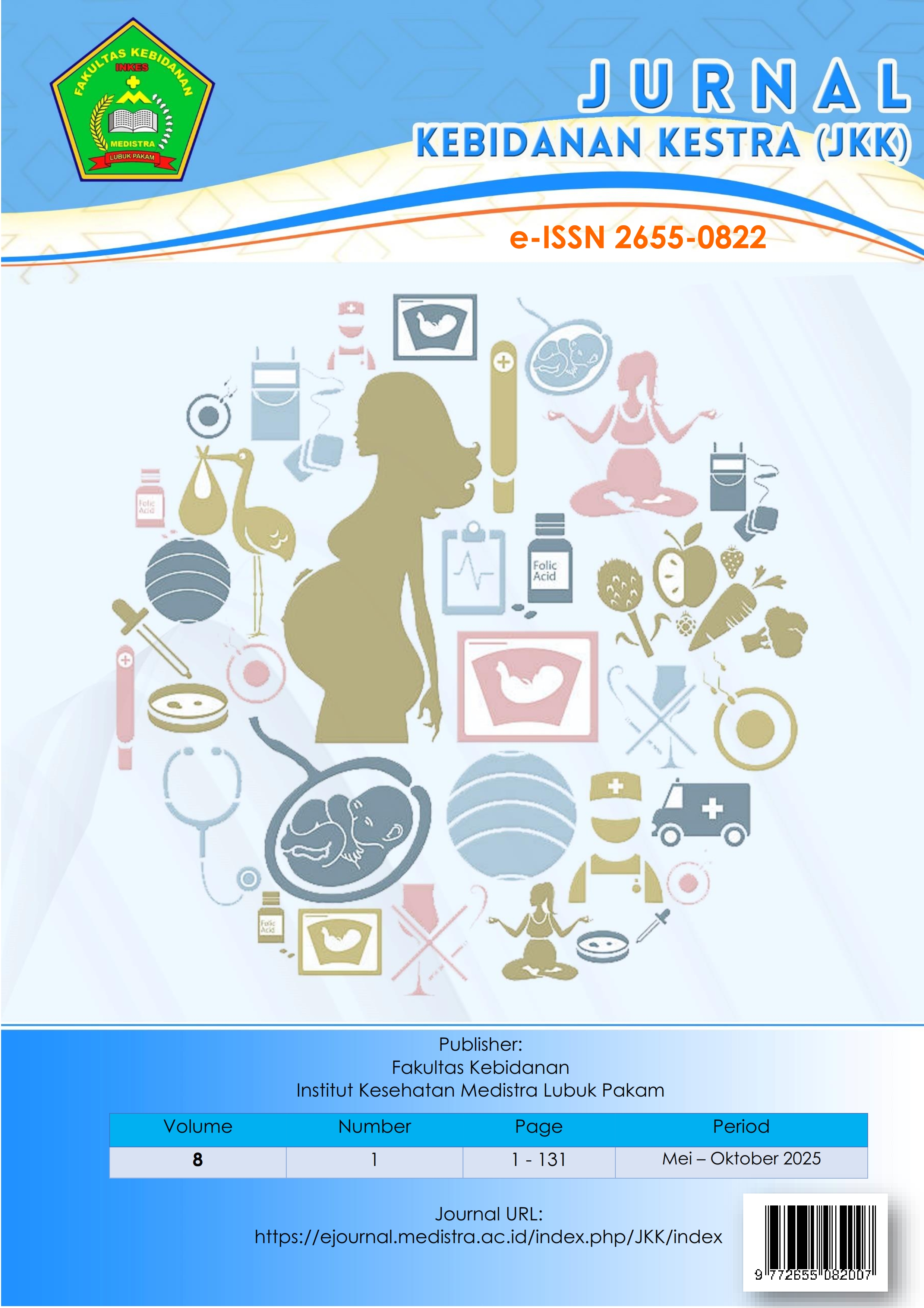The Relationship Between The Level Of Knowledge And The Implementation Of Early Mobilization On Wound Healing In Post-Caesarean Section Mothers At The Kotamobagu City Hospital.
DOI:
https://doi.org/10.35451/4660hm04Keywords:
Mobilisasi Dini, Penyembuhan Luka, Section Caesarea, Tingkat Pengetahuan, Ibu Post SCAbstract
The healing process of incisional wounds after cesarean section (SC) surgery is a multifactorial outcome influenced by both cognitive and behavioral aspects, particularly the mother's level of knowledge and the implementation of early mobilization. Early mobilization is proven to accelerate tissue repair by enhancing physiological recovery mechanisms, yet its effectiveness highly depends on the mother’s understanding and willingness to initiate movement postoperatively. This study aims to examine the relationship between knowledge level and early mobilization practices on wound healing outcomes among post-SC mothers at the Regional Public Hospital (RSUD) of Kota Kotamobagu. A quantitative analytic study was conducted using a cross-sectional design, involving 40 respondents selected through total sampling. Data were collected via structured questionnaires and clinical observation of wound healing on the third postoperative day. Statistical analyses included Chi-Square tests and multivariate logistic regression. The results showed that all mothers with low knowledge or poor mobilization practices experienced delayed wound healing, whereas those with moderate to high knowledge and proper mobilization demonstrated optimal recovery. A p-value of 0.000 was obtained for both variables, indicating a highly significant relationship. Early mobilization was the strongest predictor of wound healing success (OR = 25.98), followed by good knowledge levels (OR = 8.52). The study concludes that both knowledge and early mobilization behavior significantly contribute to postoperative recovery in SC patients. Educational reinforcement and psychosocial support during hospitalization are essential to promote early mobilization practices and empower mothers in participating actively in their healing process.
Downloads
References
[1] A. Rachman, I. Purnamasari, and B. Trihandini, “Hubungan Mobilisasi Dini Dengan Intensitas Nyeri Post Operasi Sectio Caesarea Di RSUD H. Boejasin Pelaihari,” J. Keperawatan Suaka Insa., vol. 8, no. 2, 2023, doi: 10.51143/jksi.v8i2.464.
[2] Riandari, S. Susilaningsih, and W. Agustina, “Faktor-Faktor Yang Mempengaruhi Proses Penyembuhan Luka Pada Pasien Post Operasi Sectio Caesaria,” Prof. Heal. J., vol. 2, no. 1, 2020, doi: 10.54832/phj.v2i1.117.
[3] D. Widayati, F. Hayati, and D. R. Fajarotin, “Peningkatan kenyamanan dan early mobilization pada ibu post SC melalui efflurage back massage,” J. Ris. Kebidanan Indones., vol. 6, no. 1, 2022, doi: 10.32536/jrki.v6i1.217.
[4] E. Suharja, R. Widowati, and S. Novelia, “Factors Related to Perineal Wound Healing in Postpartum Mothers at Jawilan Public Health Center,” Nurs. Heal. Sci. J., vol. 2, no. 2, 2022, doi: 10.53713/nhs.v2i2.72.
[5] S. N. H. Saleh, “Analisis Pemberian Mobilisasi Dini Post Sectio Caesarea Dengan Proses Penyembuhan Luka Operasi Di Ruang Nifas Rumah Sakit Umum Daerah Kota Kota Mobagu,” J. IMJ Indones. Midwifery J., vol. 4, no. 1, pp. 1–5, 2020.
[6] Endang Ekawati, Meity Albertina, and Hesti Prawita Widiastuti, “Pengaruh Mobilisasi Dini Terhadap Nyeri Luka Ibu Post Operasi Secsio Caesarea di Ruang Nifas RSUD Panglima Sebaya Tana Paser Tahun 2022,” J. Ilmu Kebidanan dan Kesehat. (Journal Midwifery Sci. Heal., vol. 15, no. 1, pp. 14–20, 2024, doi: 10.52299/jks.v15i1.156.
[7] Y. maya Pesa, “Hubungan Mobilisasi Dini Post Sectio Caesar (Sc) Dengan Proses Penyembuhan Luka Operasi Di RSUD DR.RM.PRATOMO,” Al-Insyirah Midwifery J. Ilmu Kebidanan (Journal Midwifery Sci., vol. 9, no. 2, 2020, doi: 10.35328/kebidanan.v9i2.663.
[8] N. Supardi and F. Yani, “Pengaruh Mobilisasi Dini Terhadap Penyembuhan Luka Perineum Ruptur Tingkat II Pada Ibu Post Partum di Puskesmas Kassi-Kassi Makassar Tahun 2019,” Madu J. Kesehat., vol. 9, no. 2, 2020, doi: 10.31314/mjk.9.2.5-13.2020.
[9] R. N. Santiasari, L. Mahayati, and A. D. Sari, “TEKHNIK NON FARMAKOLOGI MOBILISASI DINI PADA NYERI POST SC,” J. Kebidanan, vol. 10, no. 1, 2021, doi: 10.47560/keb.v10i1.274.
[10] L. Y. Armayanti, A. A. I. Nataningrat, and N. M. K. Sumiari Tangkas, “Hubungan Mobilisasi Dini Terhadap Penyembuhan Luka Sectio Caesarea (SC) Di Ruang Nifas Rumah Sakit Umum Daerah Klungkung,” J. Ris. Kesehat. Nas., vol. 8, no. 1, pp. 69–74, 2024, doi: 10.37294/jrkn.v8i1.562.
[11] W. Nuraisya and T. A. R. Amalia, “Asuhan Kebidanan Ibu Post SC dengan Teknik Relaksasi Genggam Jari pada Masalah Nyeri Luka Jahitan di RS Amelia Pare-Kediri,” J. Vokasi Kesehat., vol. 1, no. 2, 2022, doi: 10.58222/juvokes.v1i2.44.
[12] F. Fahira, R. Ratnawati, and T. D. Yogastina, “Penerapan Teknik Mobilisasi Dini Pada Ibu Post Sectio Caesarea Terhadap Penyembuhan Luka Tahap Awal Di RSUD Tugurejo Semarang : Case Study,” J. Ilm. JKA (Jurnal Kesehat. Aeromedika), vol. 9, no. 2, 2023, doi: 10.58550/jka.v9i2.213.
[13] A. Azimatu Sa’diyyah, T. Kartilah, and T. Nurhayati, “Asuhan Keperawatan Pada Ibu Post Sectio Caesarea Yang Dilakukan Mobilisasi Dini Dalam Peningkatan Penyembuhan Luka Di RSUD DR. Soekardjo Tasikmalaya,” Tasikmalaya Nurs. J., vol. 1, no. 1, 2023, doi: 10.37160/tnj.v1i1.254.
[14] E. P. Saragih, “Mobilisasi Dini, Asupan Nutrisi dan Personal Hygiene dan Hubungannya dengan Proses Penyembuhan Luka Post Operasi Sectio Caesarea,” SIMFISIS J. Kebidanan Indones., vol. 3, no. 1, 2023, doi: 10.53801/sjki.v3i1.171.
[15] F. E. Cahyawati and A. Wahyuni, “Mobilisasi Dini Pada Ibu Postpartum Dengan Sectio Caesarea terhadap Penurunan Intensitas Nyeri Luka Operasi,” J. Kesehat. PERINTIS (Perintis’s Heal. Journal), vol. 10, no. 1, 2023, doi: 10.33653/jkp.v10i1.951.
[16] S. Mulyanah and A. S. Rini, “Hubungan Mobilisasi Dini, Nutrisi dan Peran Bidan terhadap Penyembuhan Luka Operasi Sectio Caesarea di RSUD Malingping Tahun 2022,” Open Access Jakarta J. Heal. Sci., vol. 2, no. 4, 2023, doi: 10.53801/oajjhs.v2i4.127.
[17] Yuli Suryanti, Vera Yuanita, Fyzria Qudratullah, and Sri Emilda, “Mobilisasi Dini Untuk Penyembuhan Luka Post Operasi Sectio Caesaera (Studi Literatur),” J. Kesehat. dan Pembang., vol. 14, no. 27, 2024, doi: 10.52047/jkp.v14i27.306.
[18] N. A. Rangkuti, Y. Zein, N. S. Batubara, M. A. Harahap, and M. A. Sodikin, “Hubungan Mobilisasi Dini Post Sectio Caesarea Dengan Proses Penyembuhan Luka Operasi Di RSUD PANDAN,” J. Educ. Dev., vol. 11, no. 1, 2023, doi: 10.37081/ed.v11i1.4563.
[19] J. Rottie and R. E. Saragih, “Pengaruh Mobilisasi Dini Terhadap Penyembuhan Luka Post Sectio Caesarea Di Irina D Bawah RSUP Prof Dr. R. D. Kandou Manado,” J. Community Emerg., vol. 7, pp. 431–440, 2020.
[20] R. E. Trisnawati, M. S. Manggul, and V. Hamat, “Determinan Yang Berhubungan Dengan Kejadian Infeksi Luka Sectio Caesarea,” Qual. J. Kesehat., vol. 17, no. 2, 2023, doi: 10.36082/qjk.v17i2.1249.
Downloads
Published
Issue
Section
License
Copyright (c) 2025 Dinalisnawaty Akri Daeng Maeta, Widia Shofa Ilmiah

This work is licensed under a Creative Commons Attribution 4.0 International License.
Copyright in each article is the property of the Author.



























